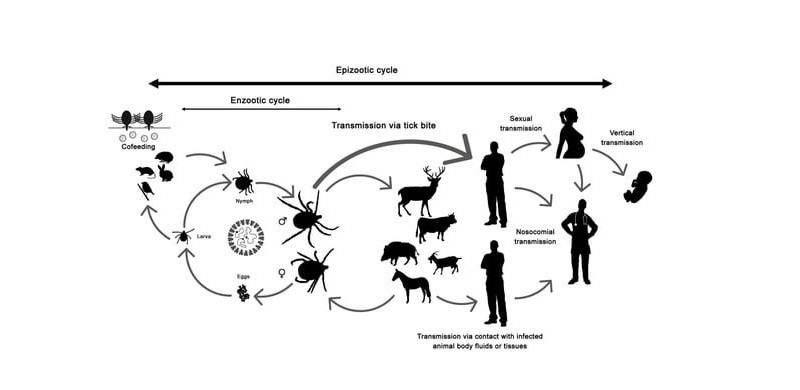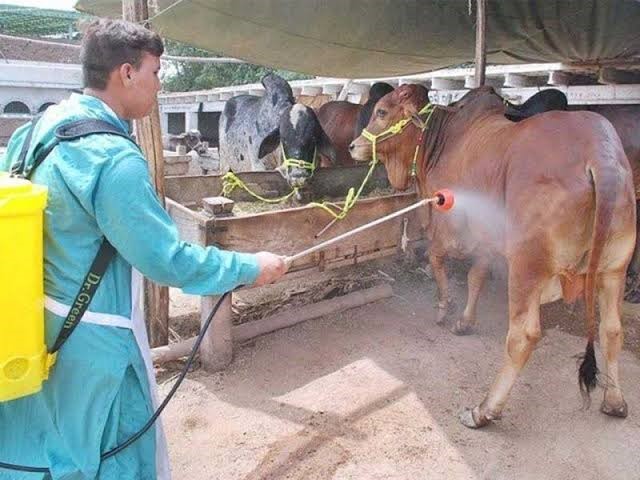
Crimean–Congo hemorrhagic fever (CCHF) is a viral disease of humans. It is caused by the Nairovirus of family Bunyaviridae. Incubation period of the disease is 5-6 days. Studies on sero-epidemiology indicate that the disease is asymptomatic in more than 80% cases. Signs and symptoms include muscle pain, headache, high fever, back pain, joint pain, stomach pain, vomiting, red eyes, flushed face, red throat and petechiae. Influenza-like symptoms appear at the initial stage of the disease, which later progress to severe bleeding. Complications may appear in the form of liver failure in those who survive, and recovery generally occurs around two weeks after onset. The CCHF virus causes severe viral hemorrhagic fever outbreaks, with a case fatality rate of 10–40%.
In the Eastern Mediterranean region, CCHF has been reported from Iran, Afghanistan, Oman, Pakistan, United Arab Emirates, Sudan and Saudi Arabia. Till now, five genotypes of CCHF (1,2,3,4, and 7) have been identified in these countries. However, the prevalence of disease is increasing continuously due to unavailability of vaccine, lack of safety measures and persistent increase in the population of tick vectors.
Humans get infection by direct contact with the ticks or livestock animals. CCHF can be transmitted from one infected human to another by contact with infectious blood or body fluids. Sexual transmission of disease in humans has also been reported. Most of the cases (70%) of CCHF have a history of tick bite.
Laboratory tests that are used to diagnose CCHF include Antigen-capture enzyme-linked immunosorbent assay (ELISA), real time polymerase chain reaction (RT-PCR), virus isolation attempts, detection of antibody by ELISA (IgG and IgM), immunohistochemical staining can also show of viral antigen in formalin-fixed tissues.
Treatment for CCHF is primarily supportive. Care should include careful attention to fluid balance and correction of electrolyte abnormalities, oxygenation and hemodynamic support and appropriate treatment of secondary infections. The virus is sensitive in vitro to the antiviral drug ribavirin.
The following guidelines have been proposed by Department of Zoonotic and Vector Borne Diseases, Epidemic Investigation Cell, National Institute of Health, Pakistan, in order to prevent the occurrence and transmission of CCHF:
In the Eastern Mediterranean region, CCHF has been reported from Iran, Afghanistan, Oman, Pakistan, United Arab Emirates, Sudan and Saudi Arabia. Till now, five genotypes of CCHF (1,2,3,4, and 7) have been identified in these countries. However, the prevalence of disease is increasing continuously due to unavailability of vaccine, lack of safety measures and persistent increase in the population of tick vectors.
Humans get infection by direct contact with the ticks or livestock animals. CCHF can be transmitted from one infected human to another by contact with infectious blood or body fluids. Sexual transmission of disease in humans has also been reported. Most of the cases (70%) of CCHF have a history of tick bite.
Laboratory tests that are used to diagnose CCHF include Antigen-capture enzyme-linked immunosorbent assay (ELISA), real time polymerase chain reaction (RT-PCR), virus isolation attempts, detection of antibody by ELISA (IgG and IgM), immunohistochemical staining can also show of viral antigen in formalin-fixed tissues.
Treatment for CCHF is primarily supportive. Care should include careful attention to fluid balance and correction of electrolyte abnormalities, oxygenation and hemodynamic support and appropriate treatment of secondary infections. The virus is sensitive in vitro to the antiviral drug ribavirin.
The following guidelines have been proposed by Department of Zoonotic and Vector Borne Diseases, Epidemic Investigation Cell, National Institute of Health, Pakistan, in order to prevent the occurrence and transmission of CCHF:

- Agricultural workers and others working with animals should use insect repellent on exposed skin and clothing.
- Animals brought from areas where prevalence of CCHF is high must be treated at entry points with acaricides.
- Dusting and liquid sprays containing insecticides should be used in case of herds. It is very important to treat different regions of the animals, particularly the belly, head, neck and back of the head. Insecticide spray should also be done on the wall cracks and other regions where animals are kept.
- In case of a high load of ticks at a farm, spray should be done after every four weeks.
- Acaricide application twice a season is enough to control ticks on a farm.
- Acaricide should be sprayed fifteen days before slaughtering of animals.
- Repellents should be used, particularly on the face, arms and foot. Insect repellents containing DEET (N, N-diethyl-m-toluamide) are the most effective in warding off ticks.
- Wearing gloves and other protective clothing is recommended when there is a chance of contact with the skin or mucus membrane of viremic animals, particularly when blood and tissue are handled.
- While visiting an animal area, wear light-coloured clothes so that any tick can easily be detected.
- Avoid visiting farms or areas where ticks are abundant.
- Grasses and weeds should be removed from the sheds of animal and houses.
- All items responsible for attracting rodents carrying ticks should be removed.
- If any rodent burrow is discovered in your home or livestock shed, destroy them.
- Consumption of unpasteurized milk and uncooked meat should be avoided.
- Safe burial practices including the use of liquid bleach solution as disinfectant and covering the body in polythene bag have been published.
- CCHFV can be inactivated by disinfectant including 1 % hypochlorite and 2% glutaraldehyde.
- There should be entry check points in cattle market.
- Ticks should not be removed with bare hands as the disease may present in tick secretions.
- Tweezers must be used in order to remove ticks from the body of the animal. Hold the tick firmly and pull it out. Don’t give a twist to it.
- The bite area should be washed with soap and water and then apply antiseptics to it.
- If a person face illness or fever after visiting a farm, immediately contact a physician and tell them about your visit to the animal shed where tick borne diseases are prevalent.
- Prophylactic treatment with ribavirin has occasionally been used after high-risk exposure but its role is controversial.

